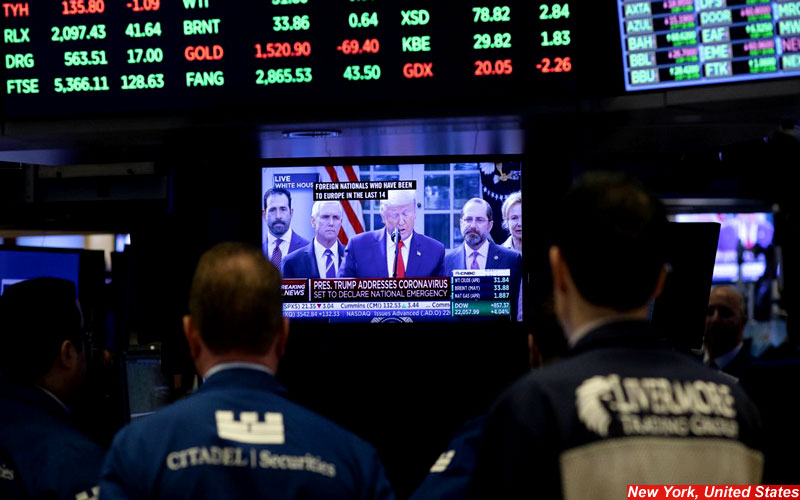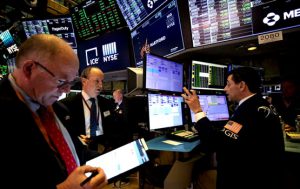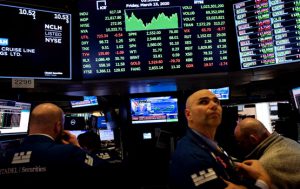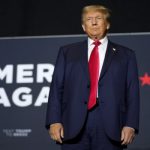
NEW YORK (AP) — Wall Street roared back from its worst day in 30 years Friday with a broad rally that sent the Dow Jones Industrial Average nearly 2,000 points higher — its biggest point gain ever — after President Donald Trump declared the coronavirus pandemic a national emergency.
Fueled by a late-day surge while Trump was speaking, the Dow saw its largest percentage gain since 2008. The rally recouped many of the losses from a day earlier, when the index experienced its worst slide since the Black Monday crash of 1987 and European indexes had one of the worst drops on record. The major indexes each closed with gains of more than 9%.
The session capped a dizzying week on Wall Street, with wild swings driven largely by uncertainty over how much damage the coronavirus would cause to the global economy. By Thursday, the Dow had suffered two drops of more than 2,000 points and the longest-ever bull market had ended.
Then on Friday stocks rallied, shooting sharply upward in the last half-hour of trading as investors appeared to gain confidence that the Trump administration has a plan to combat the outbreak from both a health care and economic perspective.
Despite Friday’s pickup, the market still ended the week with its second-worst weekly loss in the past 10 years. All the major indexes are in what traders call a bear market.
Investors have been clamoring for strong action from the U.S. government to combat the outbreak’s effect on businesses and workers. News that the White House and Congress were close to announcing an agreement on a package to provide sick pay, free testing and other resources helped boost the market in the morning.

“We’re finally getting that a little late to the party, but it’s better to be late to the party then not to come to the party,” said Ryan Detrick, senior market strategist at LPL Financial. He said the stimulus plan should help cushion the financial effects on people and businesses.
Trump spoke to the nation twice this week about the coronavirus, and the stock market had decidedly different reactions each time.
On Wednesday night, Trump announced restrictions on travel from Europe and some seemingly minor economic measures. Global markets sold off, fearful that the U.S. and other countries lacked a strong response to the outbreak. That changed Friday afternoon, when Trump declared the national emergency, which frees up funds for states and cities to fight the virus. He also announced measures to shore up oil prices, ease the economic burden on students and improve the level of testing in the U.S. for the virus.
Trump’s news conference, which also featured remarks from health experts, helped reassure investors that the administration is now taking aggressive action to limit the spread of the virus, said Quincy Krosby, chief market strategist at Prudential Financial.
“What the market was focused on today was the containment of the virus. That’s always been the top concern and a concern that the administration was behind the curve on,” Krosby said. She described the steps outlined by the president and experts as “positive and optimistic.”
“And that’s exactly what the market needed and the country needed today,” she said.
Speaker Nancy Pelosi announced a deal Friday with the Trump administration for an aid package from Congress that would provide free tests, sick pay for workers and bolster food programs.
The market’s rout intensified this week amid a torrent of cancellations and shutdowns worldwide. Business closures have fueled fear that a severe pullback in consumer and business spending will tip the U.S. economy into a recession and wreck corporate profits.
The virus has infected over 137,000 people worldwide. More than 5,000 have died, but half of those who had the virus have already recovered. The pandemic’s new epicenter is Europe. In the United States, cases have topped 1,600, while 41 people have died, according to the Centers For Disease Control and Prevention.

Friday’s rally was broad, with technology stocks accounting for a big slice of the gains. Shares in cruise line operators, airlines and hotels — among the hardest-hit stocks as people canceled vacations and companies shut down business trips — headed higher.
Investors’ anticipation of a government stimulus effort and a rate cut by the Fed next week put traders in a buying mood.
On Thursday, the Federal Reserve unveiled a massive short-term lending program to try to help smooth trading in U.S. Treasurys. Many economists expect the Fed will move to cut interest rates by a full percentage point, to nearly zero, at its meeting of policymakers next Wednesday.
This week’s historic sell-off helped to wipe out most of the big gains since President Trump took office in 2017. After hitting an all-time high on Feb. 19, the S&P 500 fell more than 20%, officially ending Wall Street’s unprecedented bull-market run of nearly 11 years. The slide into a bear market has been the fastest since World War II.
The selling has been so swift and sharp that there remains the potential for a significant bounce after the virus and its impact begin to recede, Detrick said. The economy was already on solid footing, and well-known companies like Disney and Apple could help lead a recovery.
He also said there could be a recession on the horizon, but it would likely be mild. “It could be a shallow, quick, violent, scary recession, but one that bounces back quickly,” Detrick said.
Also Friday, Warren Buffett said the annual shareholder meeting for Berkshire Hathaway will be streamed live in early May without any attendees, apart from maybe select journalists. The meeting normally draws a crowd to rival professional sporting events.
For most people, the new coronavirus causes only mild or moderate symptoms, such as fever and cough. For some, especially older adults and people with existing health problems, it can cause more severe illnesses, including pneumonia. The vast majority of people recover in a few weeks.
For now, investors must wait for more information.
“What markets are trying to do is understand what the cycle of the virus is, and then the human reaction to it,” said Thomas Martin, senior portfolio manager at Globalt Investments in Atlanta.
____
Newsroom | theworldail.co.uk
Source/Contribution/Photo Credit by Associated Press






